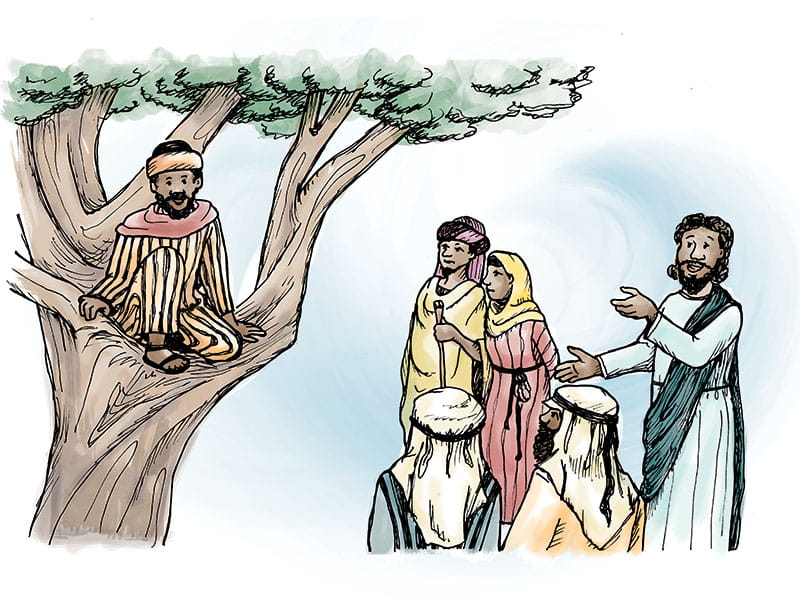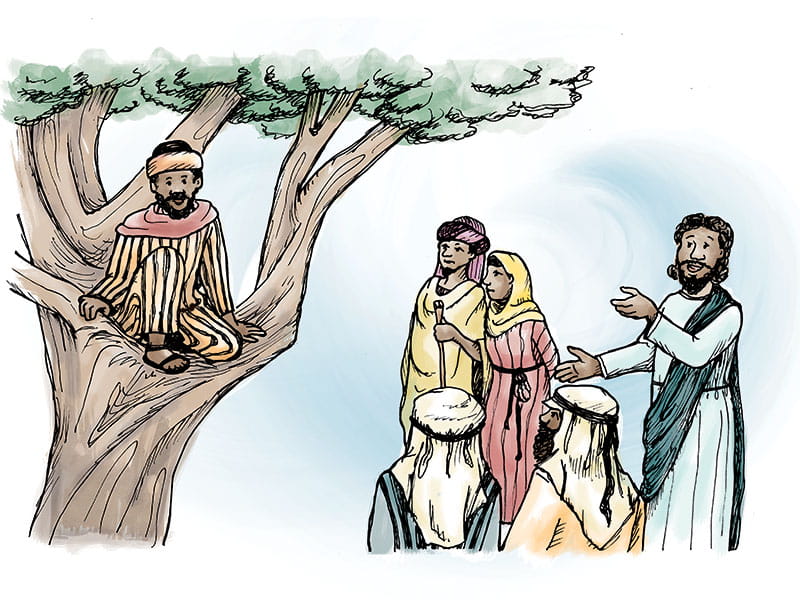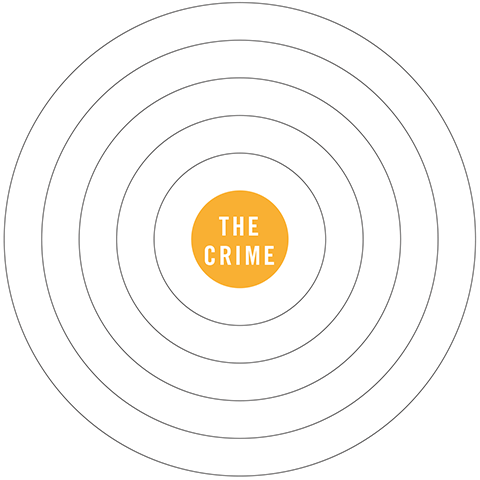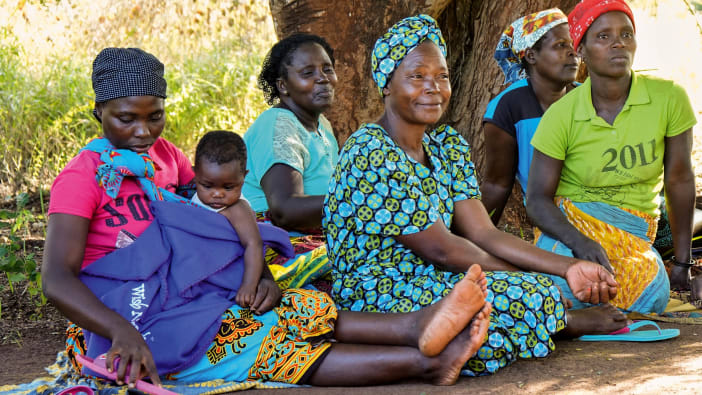Typically, justice systems around the world focus solely on punishing the wrongdoer. Critics of this system point to its many flaws: most prisoners reoffend within five years, and victims of crime are generally ignored unless they are needed as witnesses. But in the last 40 years a movement has emerged that suggests a better way...

Articles
What is restorative justice?
Restorative justice is different from traditional criminal justice in three important ways
2018 Available in English, French, Portuguese and Spanish

From: Prisons – Footsteps 104
Practical tips for getting involved in prison ministry and caring for ex-offenders


The Sycamore Tree Project restorative justice course takes its name from the story of Zacchaeus. Illustration from Petra Röhr-Rouendaal, Where there is no artist (second edition)
A different approach
Restorative justice is a response to crime that emphasises healing the wounds that criminal behaviour causes or reveals in victims, offenders and communities. It involves a way of thinking about crime and its effects that is different from traditional criminal justice in three important ways:
- A restorative perspective focuses our attention on the healing of victims that needs to take place after a crime.
- Restorative justice underlines the obligation of offenders to repair the damage they have caused by making amends to the people they have harmed.
- Restorative justice seeks to involve all parties who have been affected by the crime and who have a stake in its resolution, or in the prevention of similar crimes in the future.
Restorative justice programmes often involve bringing offenders and victims together to share their experiences. They do not have to be each other’s actual offenders and victims, although in some cases this is possible. These programmes give offenders the opportunity to understand the harm that crime causes and consider practical steps they could take to make amends. Victims have the chance to reflect on their own experiences in a way that assists their healing, and to understand the humanity of offenders.
Restorative justice approaches are now being put into practice all over the world. For example, in Rwanda, elements of restorative justice have been used successfully with perpetrators and survivors of the 1994 genocide.
The Sycamore Tree Project®
The Sycamore Tree Project is a restorative justice course that was started in 1996 by Prison Fellowship International. The course arranges for crime victims to come into prisons and take part in a number of group sessions together with prisoners. The prisoners and victims are not related; they are not each other’s victims and offenders.
A trained facilitator guides the group through a series of topics, such as:
- responsibility
- telling your story
- forgiveness
- making amends
- building peace.
At the end of the course, offenders share letters and resolutions that express how they feel about the past and how they wish to move forward. Victims consider ways in which they can take control of their lives and continue their journey towards healing and restoration. The group’s final meeting is a time of public celebration.
The programme takes its name from the biblical story of Zacchaeus and his encounter with Jesus (Luke 19:1–10). Zacchaeus confessed his wrongdoing, repented and tried to put right the wrongs he had done to others. Although the Sycamore Tree Project uses biblical principles, there is no requirement for participants to be Christians. The most recent edition of the course, Sycamore Tree Project® NEW LEAF, contains two versions: the standard version that freely uses biblical stories, and an alternative version for contexts where public expressions of Christianity are not permitted.
Benefits on both sides
Research studies of the Sycamore Tree Project have shown that the programme benefits both victims and offenders. It increases prisoners’ empathy for victims and changes their attitudes away from reoffending. It also increases victims’ sense of well‑being and decreases their anxiety and depression. One prisoner in England who participated in the programme said, ‘The course has made me appreciate and understand the effects my offending has had on my family, friends and the victims. It has also given me a stronger resolve for the future.’
A victim who took part in the course in New Zealand said, ‘It’s been a life-changing opportunity. Having been a victim of crime, I needed a lot of answers to a lot of questions. It has not yet solved them all for me, but I am a better, more understanding and, I think, more forgiving person than I was.’

Activity: The Ripple Effect
This is a sample activity from the Sycamore Tree Project course. Its aim is to help prisoner participants to understand the effects of crime on victims and communities.
You will need:
- An unbreakable bowl or bucket
- Water to fill the bucket
- A small item such as a stone.
Demonstration
Take the bucket filled with water and the stone. In dramatic language, describe the impact of a large rock being thrown into a still pool of water. As you describe the rock hitting the water, throw the stone into the bucket of water as a visual demonstration of the impact. Ask participants:
- What happens after the rock hits the water?
- What happens after the rock disappears below the surface?
They will note that the ripples continue after the initial impact and last for a long time before slowly fading away.
Individually
Give all the participants a copy of the diagram below. Ask them to think about the crime they were involved in. In your own words, tell them:
- Pretend that, like a stone dropped in water, the crime creates ripples spreading out to touch more and more people.
- In each one of the circles, write the name of the people or groups that were harmed by your crime. The immediate victim and you would be closest to the centre. Then think about other people who were affected (for example, the immediate victim’s family and friends, your family and friends, community members, and so on) and add their names in the next circles.
As a group
In a circle, encourage the group to discuss what this exercise tells us about the ongoing effect of a crime after it takes place.
Tips for facilitators
The Ripple Effect exercise is memorable for prisoners.
- Be sure to talk to the prison authorities to get their permission to bring the bucket and stone into the prison.
- You could do the same exercise but with a very small coin and challenge the participants to put the coin in the bowl without disturbing the surface of the water. This demonstrates that it is not possible to avoid making ripples.
This article was adapted from resources kindly supplied by Prison Fellowship International.
To learn more about the Sycamore Tree Project NEW LEAF, please contact Prison Fellowship International.
Web: www.pfi.org Email: [email protected]
View or download this resource
Get this resource
Get this resource
Similarly Tagged Content
Share this resource
If you found this resource useful, please share it with others so they can benefit too.

Subscribe to Footsteps magazine
A free digital and print magazine for community development workers. Covering a diverse range of topics, it is published three times a year.
Sign up now - Subscribe to Footsteps magazine





